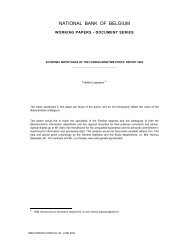A multi-factor model for the valuation and risk management of ...
A multi-factor model for the valuation and risk management of ...
A multi-factor model for the valuation and risk management of ...
Create successful ePaper yourself
Turn your PDF publications into a flip-book with our unique Google optimized e-Paper software.
The results in Table 10 show that premium <strong>and</strong> IRE estimates vary across banks, although not<br />
to <strong>the</strong> same extent as <strong>the</strong> cross-sectional variability reported by Hutchison <strong>and</strong> Pennacchi (1996)<br />
<strong>and</strong> O’Brien (2000) <strong>for</strong> US NOW <strong>and</strong> MMDA data (recall Table 2 in Section 2.3). Of course, <strong>the</strong><br />
premium <strong>and</strong> IRE estimates in Table 10 are just point estimates that hold <strong>for</strong> speci…c assumptions<br />
about <strong>the</strong> servicing cost <strong>and</strong> decay rate parameters <strong>and</strong> starting from <strong>the</strong> unconditional <strong>factor</strong><br />
averages. It would be desirable to know (i) to what extent deposit premium <strong>and</strong> IRE estimates<br />
change when <strong>the</strong> two main <strong>model</strong> parameters, servicing costs <strong>and</strong> decay rates, change, <strong>and</strong> (ii) how<br />
certain we are about <strong>the</strong> reported point estimates, i.e. what range <strong>of</strong> estimates one gets when one<br />
r<strong>and</strong>omly draws starting values from <strong>the</strong> yield curve <strong>factor</strong> distributions <strong>for</strong> a given set <strong>of</strong> <strong>model</strong><br />
parameters.<br />
With respect to <strong>the</strong> …rst question above, Table 11 reports premium <strong>and</strong> IRE estimates <strong>for</strong> a matrix<br />
<strong>of</strong> servicing cost <strong>and</strong> average decay rate <strong>model</strong> parameter assumptions. For a given servicing cost,<br />
premiums are expected to be smaller when decay rates are higher. Likewise, <strong>for</strong> a given decay<br />
rate, premiums are expected to be smaller when servicing costs are higher. Table 11 Panel A<br />
reports premiums averaged across all banks (<strong>and</strong> simulations). 17 As expected, estimated premiums<br />
decrease <strong>for</strong> a given decay rate with increasing servicing cost <strong>and</strong> <strong>for</strong> a given servicing cost with<br />
increasing decay rates. For example, when <strong>the</strong> servicing cost is 1%, a decay rate <strong>of</strong> 10% (halving<br />
time <strong>of</strong> approx. 10 years) leads to a premium <strong>of</strong> 23%, while a decay rate <strong>of</strong> 30% (halving time<br />
<strong>of</strong> approx. 2.5 years) gives rise to a much smaller 10% premium. We see that premiums are<br />
never smaller than 6.5% when <strong>the</strong> servicing cost does not exceed 1% (<strong>for</strong> decay rates below 50%).<br />
Alternatively, <strong>for</strong> servicing costs up to 2% premiums always exceed 4.4% <strong>for</strong> all considered decay<br />
rates. Of course, if both servicing costs <strong>and</strong> decay rates are set at high levels, deposit premiums<br />
become arbitrarily small <strong>and</strong> may even become negative. Table 11 Panels B-D give corresponding<br />
results <strong>for</strong> IRE estimates. IREs are relatively insensitive to di¤erent servicing cost assumptions,<br />
but more strongly a¤ected by average decay rate assumptions. IREs di¤er dramatically across <strong>the</strong><br />
di¤erent yield curve <strong>factor</strong>s. The sensitivity <strong>of</strong> <strong>the</strong> IRE estimates to di¤erent withdrawal rates<br />
is particularly dependent on <strong>the</strong> type <strong>of</strong> IRE (slope versus level). Recall that <strong>the</strong> level <strong>factor</strong><br />
IREs can be interpreted as proxies <strong>of</strong> modi…ed duration. They are relatively stable throughout<br />
Panel B <strong>and</strong> roughly lie in <strong>the</strong> [-3.8, -3.2] range. With respect to <strong>the</strong> size <strong>of</strong> <strong>the</strong>se estimates, <strong>the</strong><br />
reader is reminded that Belgian savings deposits accounts are somewhat special in <strong>the</strong> sense that<br />
speci…c price regulation applies to <strong>the</strong>m. Speci…cally, <strong>the</strong> remuneration <strong>of</strong> savings deposits is at<br />
<strong>the</strong> discretion <strong>of</strong> <strong>the</strong> banks, but must always consist <strong>of</strong> a base rate on <strong>the</strong> one h<strong>and</strong> <strong>and</strong> a growth or<br />
loyalty premium on <strong>the</strong> o<strong>the</strong>r h<strong>and</strong>. While <strong>the</strong> base rate is paid out proportionally with time (pro<br />
rata), <strong>the</strong> payout <strong>of</strong> <strong>the</strong> premium components hinges upon <strong>the</strong> time <strong>the</strong> (new) deposits remain on<br />
<strong>the</strong> account (typically uninterrupted 6 to 12 month periods are required) <strong>and</strong> on intricate daycount<br />
conventions. These premia are <strong>the</strong>re<strong>for</strong>e partially responsible <strong>for</strong> <strong>the</strong> relative stability <strong>of</strong> Belgian<br />
banks’savings deposits balances.<br />
Figures 10 <strong>and</strong> 11 address <strong>the</strong> second question by presenting evidence about <strong>the</strong> distribution <strong>of</strong><br />
average deposit premiums <strong>and</strong> IREs when <strong>factor</strong>s start from di¤erent vectors r<strong>and</strong>omly drawn<br />
from <strong>the</strong> <strong>factor</strong>s’<strong>multi</strong>variate normal distribution, where we again …x <strong>the</strong> servicing cost to 0% <strong>and</strong><br />
<strong>the</strong> decay rate to 15%. From Figure 10, deposit premiums can be seen to roughly vary between<br />
22% <strong>and</strong> 25% <strong>for</strong> <strong>the</strong> Big 4 banks <strong>and</strong> between 20% <strong>and</strong> 22% <strong>for</strong> medium-sized banks, which<br />
can be considered fairly narrow <strong>and</strong> thus accurate. Corresponding ranges <strong>for</strong> IRE estimates are<br />
relatively wide <strong>and</strong> seem to imply that IREs are more di¢ cult to measure accurately. For example,<br />
<strong>the</strong> level <strong>factor</strong> IRE seems to vary between -4.5 <strong>and</strong> -2.5, while similarly wide distributions result<br />
<strong>for</strong> <strong>factor</strong>s 2 <strong>and</strong> 3. This seems to con…rm that IREs cannot be measured with great accuracy.<br />
Notwithst<strong>and</strong>ing <strong>the</strong> implied uncertainty around <strong>the</strong> point estimate, <strong>the</strong>se …ndings seem to con…rm<br />
17 Sets <strong>of</strong> results that distinguish between average big 4 <strong>and</strong> average medium-sized banks are not reported here but<br />
are available upon request. Big 4 bank premiums exceed those <strong>of</strong> medium-sized banks in all cases, ceteris paribus.<br />
18
















